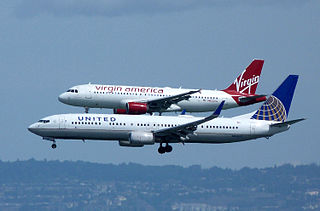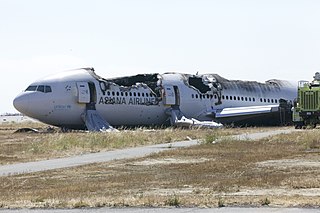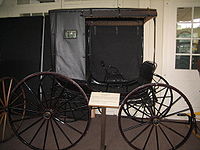
An airliner is a type of airplane for transporting passengers and air cargo. Such aircraft are most often operated by airlines. The modern and most common variant of the airliner is a long, tube shaped, and jet powered aircraft. The largest of them are wide-body jets which are also called twin-aisle because they generally have two separate aisles running from the front to the back of the passenger cabin. These are usually used for long-haul flights between airline hubs and major cities. A smaller, more common class of airliners is the narrow-body or single-aisle. These are generally used for short to medium-distance flights with fewer passengers than their wide-body counterparts.

A flight attendant, also known as a steward or stewardess, or air host or hostess, is a member of the aircrew aboard commercial flights, many business jets and some government aircraft. Collectively called cabin crew, flight attendants are primarily responsible for passenger safety and comfort.

Philippine Airlines Flight 434, sometimes referred to as PAL434 or PR434, was a scheduled flight on December 11, 1994, from Manila to Tokyo with a quick stopover in Cebu on a Boeing 747-283B that was seriously damaged by a bomb, killing one passenger and damaging vital control systems, although the plane was in a repairable state. The bombing was a test run of the unsuccessful Bojinka terrorist attacks. The Boeing 747 was flying the second leg of a route from Mactan–Cebu International Airport in Cebu, Philippines to Narita International Airport, in Tokyo, Japan. After the bomb detonated, 58-year-old veteran pilot Captain Eduardo "Ed" Reyes was able to land the aircraft, saving it and the remaining passengers and crew.

Saudia Flight 163 was a scheduled Saudia passenger flight departing from Quaid-e-Azam Airport in Karachi, Pakistan, bound for Kandara Airport in Jeddah, Saudi Arabia, via Riyadh International Airport in Riyadh, Saudi Arabia, which caught fire after takeoff from Riyadh International Airport on 19 August 1980. Although the Lockheed L-1011-200 TriStar made a successful emergency landing at Riyadh, the flight crew failed to perform an emergency evacuation of the airplane, leading to the deaths of all 287 passengers and 14 crew on board the aircraft from smoke inhalation.

Air Canada Flight 797 was an international passenger flight operating from Dallas/Fort Worth International Airport to Montréal–Dorval International Airport, with an intermediate stop at Toronto Pearson International Airport.

Aircrew, also called flight crew, are personnel who operate an aircraft while in flight. The composition of a flight's crew depends on the type of aircraft, plus the flight's duration and purpose.

Miracle Landing is a 1990 American made-for-television drama film based on an in-flight accident aboard Aloha Airlines Flight 243 that occurred in April 1988. The Boeing 737-200 was flying from Hilo, Hawaii to Honolulu, Hawaii, when it experienced rapid decompression when a section of the fuselage was torn away. With one flight attendant blown from the cabin to her death and 65 others injured, the aircraft was able to make a successful emergency landing at Kahului Airport, on Maui.

USAir Flight 5050 was a passenger flight that crashed on takeoff from LaGuardia Airport in Queens, New York. As the plane took off from LaGuardia's runway 31, the plane drifted to the left. After hearing a loud bang, the pilots attempted to reject the takeoff, but were unable to stop the plane short of the end of the runway. The plane continued past the end of the runway and plunged into Bowery Bay. Two passengers were killed.

A pre-flight safety briefing is a detailed explanation given before take-off to airline passengers about the safety features of the aircraft they are aboard.

A Federal Flight Deck Officer (FFDO) is a Part 121 Airline Pilot who is trained and licensed to carry weapons and defend commercial aircraft against criminal activity and terrorism. The Federal Flight Deck Officer program is run by the Federal Air Marshal Service, and an officer's jurisdiction is the flight deck or cabin of a commercial airliner or a cargo aircraft while on duty. FFDOs are federal law enforcement officers sworn and deputized by the U.S. Department of Homeland Security.

Varig Flight 820 was a flight of the Brazilian airline Varig that departed from Galeão International Airport in Rio de Janeiro, Brazil, on 11 July 1973, for Orly Airport, in Paris, France. The plane, a Boeing 707, registration PP-VJZ, made an emergency landing in onion fields about five kilometres from Orly Airport, due to smoke in the cabin from a fire in a lavatory. The fire caused 123 deaths; there were only 11 survivors . Relief Captain Antonio Fuzimoto was the pilot who handled the controls and landed the plane in the field.

An airline seat is a seat on an airliner in which passengers are accommodated for the duration of the journey. Such seats are usually arranged in rows running across the airplane's fuselage. A diagram of such seats in an aircraft is called an aircraft seat map. Within the industry, this map is known as a LOPA.

Aircraft emergency oxygen systems or air masks are emergency equipment fitted to pressurized commercial aircraft, intended for use when the cabin pressurisation system has failed and the cabin altitude has climbed above a safe level. It consists of a number of individual yellow oxygen masks stored in compartments near passenger seats and near areas like lavatories and galleys, and an oxygen source, like a centralized gaseous cylinder or decentralized chemical oxygen generator.

An aircraft cabin is the section of an aircraft in which passengers travel. Most modern commercial aircraft are pressurized, as cruising altitudes are high enough such that the surrounding atmosphere is too thin for passengers and crew to breathe.
An exit row is a row of seats on board a commercial airliner that is next to an emergency exit. Exit rows may be next to overwing exits or full-sized exit doors.

Asiana Airlines Flight 214 was a scheduled transpacific passenger flight originating from Incheon International Airport near Seoul, South Korea. On the morning of July 6, 2013, the Boeing 777-200ER operating the flight crashed on final approach into San Francisco International Airport in the United States. Of the 307 people on board, 3 died; another 187 were injured, 49 of them seriously. Among the seriously injured were four flight attendants who were thrown onto the runway while still strapped in their seats when the tail section broke off after striking the seawall short of the runway. It was the first fatal crash of a Boeing 777 since the aircraft type entered service in 1995.

Delta Air Lines Flight 1288 was a regularly scheduled flight from Pensacola, Florida to Atlanta, Georgia. On July 6, 1996, the aircraft serving the flight, a McDonnell Douglas MD-88, was on takeoff roll from Runway 17 at Pensacola when it experienced an uncontained, catastrophic turbine engine failure that caused debris from the front compressor hub of the left engine to penetrate the left aft fuselage. The cause of the engine failure was found to have been a fault in the manufacture of the fan. The failure of the airline to spot the resulting crack in the blade was a contributing factor.
Deadheading is the practice of carrying, free of charge, a transport company's own staff on a normal passenger trip so that they can be in the right place to begin their duties. In United States railway usage, the term may also be used for movement of train crews to or from a train using another means of vehicular transportation, as passenger train service is infrequent or nonexistent in many areas.

Reeve Aleutian Airways Flight 8 was an American domestic flight from Cold Bay, Alaska, to Seattle, Washington, on June 8, 1983. Shortly after takeoff, the Lockheed L-188 Electra of Reeve Aleutian Airways was travelling over the Pacific Ocean when one of the propellers broke away from its engine and struck the fuselage, damaging the flight controls. The pilots were able to make an emergency landing at Anchorage International Airport; none of the 15 passengers and crew on board were injured in the accident.
In-flight crew relief, is a term used in commercial aviation when referring to the members of an aircrew intended to temporarily relieve active crew members of their duties during the course of a flight. The term and its role are almost exclusively applied to the secondary pilots of an aircrew, commonly referred to as relief pilots, that relieve the primary and active captain and/or first officer (co-pilot) in command of an aircraft to provide prolonged breaks for rest or sleep opportunities.




















